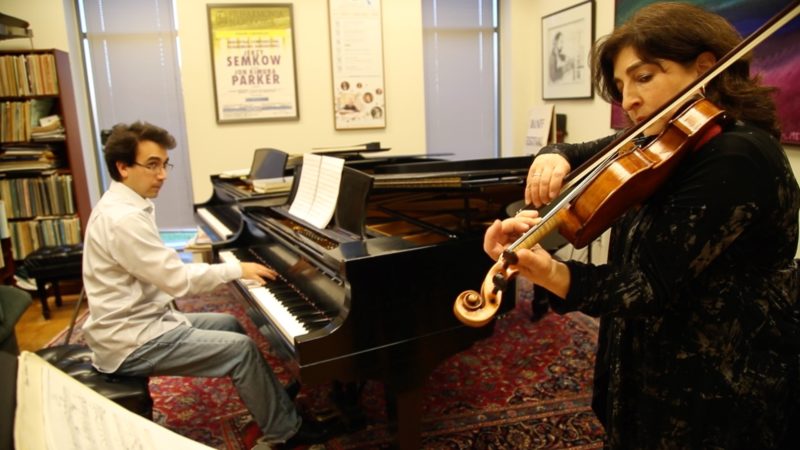
Aloysia Friedmann has graced ears around the world with her musical talent. Her career has included tours in Japan, Europe, South America and the U.S., performances with New York’s most prestigious musical ensembles and an onstage role on Broadway.
On Nov. 13, Friedmann is bringing her talent as the featured artist for ROCO’s Tasting Menu event at Midtown Arts & Theater Center Houston where she and pianist Scott Cuellar will perform Eugene Ysaÿe’s Solo Sonata No. 3 in D Minor, Op. 27; Robert Schumann’s Sonata No. 2 in D minor; and a quartet of tangos by Isaac Albeniz, Astor Piazzolla, Paul Schoenfeld and Igor Stravinsky.
Q: What makes tango music so unique that’s unmistakably irresistible?
Aloysia Friedmann: The word “tango” creates an image of a seductive, alluring dance form. The basic meter is in four, and in both the Albeniz and the Schoenfield you hear the traditional tango rhythm of long, short long, long. But within this rhythmic structure, there’s most definitely room for mood, flexibility and character.
Q: How’s a tango by Astor Piazzolla different from one by Igor Stravinsky, not to mention Isaac Albeniz and Paul Schoenfield?
Aloysia Friedmann: Both Piazzolla and Stravinsky convey tango as an attitude. But Stravinsky is gritty and sardonic, whereas Piazzolla builds on Argentinian tradition to create something new and exotic with soaring melodic lines and a slight sense of melancholy.
Albeniz treats the tango as elegant salon music, and Schoenfield, while using a more modern language, evokes elegance mixed with a dose of film noir.
Q: We hear you have a personal story about Astor Piazzolla.
Aloysia Friedmann: Back in the 1980s, before Astor Piazzolla achieved respect and renown in the classical world, he performed at the Beacon Theater in New York. As a member of the Orchestra of St. Luke’s I was thrilled to participate in his Concerto for the quintessential tango instrument, the bandoneon.
The orchestra wasn’t needed for the remainder of the concert, and although everyone else went home, I decided to stay and hear the Astor Piazzolla Tango Quintet on the second half. I sat in the front of the theater and the music, the harmonies and the rhythms captivated me immediately. There was a grittiness to it—a primal sensuality.
Shortly after, I bought Piazzolla’s Tango: Zero Hour, which became one of my favorite all-time CDs. Today, if you purchase it online, you don’t see the “liner notes” which came with it. That was such an addition to the album—a description of the real Argentinian tango. Within a few years, Piazzolla’s music started to be heard and appreciated around the world and worked its way into the classical music language.
Q: Do you have to play technically different to achieve a tango style and sound?
Aloysia Friedmann: Technically, I’ve noticed that the violin parts in all of the tangos have a lot of double stops (stopping and playing two strings at once.) Their difficulties are worth it for the added harmony and color. One feels that sliding from note to note is stylistically more welcome than it might be in more classical repertoire.
Q: Have you danced tangos? Do you dance while you play?
Aloysia Friedmann: I couldn’t begin to dance a real tango! However, it’s very natural to move in an organic way when playing music with such a strong connection to the physicality of human motion.
Q: The Eugene Ysaÿe is one tricky work: Talk about the techniques that make this such an exciting piece?
Aloysia Friedmann: The Ysaÿe Ballade for solo violin is extremely virtuosic and, yes, difficult. It also is about mood and rhythm. A ballad is essentially a narrative poem, and here, the violin tells a story. The improvisational, recitative nature of the opening minute gives way to one of the greatest rhythmical motives that a solo violinist can play, and it ends in a frenzy.
Q: This program is called Tasting Menu – another name could be Tangos and Romance or It Take Two to Tango!
I wouldn’t be able to play this concert unless I had a great pianist. I’m so happy to be playing with Scott Cuellar. He is completing his doctoral studies at The Shepherd School of Music at Rice University, and I’ve admired his playing for a number of years. To have a wonderful partner or collaborative artist (not just an accompanist) is of absolute importance. It’s like needing the perfect partner in tango dancing. Because of this, I wanted to play a big duo sonata by Robert Schumann for violin and piano.
This romantic work, written late in Schumann’s life, is somewhat dark and stormy, with the exception of a beautiful and sublime slow movement based on a Lutheran hymn. It’s a monumental composition, about 30 minutes in length. Scott will also play two short and beautiful solo piano works of Schumann to present a gentler side of the composer – a Romance and Liszt arrangement of Schumann’s love song to Clara Wieck.
The Tasting menu comes from the fact that the music and composers on this program are from Germany, Belgium, Russia, America, Spain and Argentina.
You’ll hear a sampling of music from around the world!

We heard these artists play this beautiful program last weekend on Orcas Island, Washington. It is “not to be missed!”